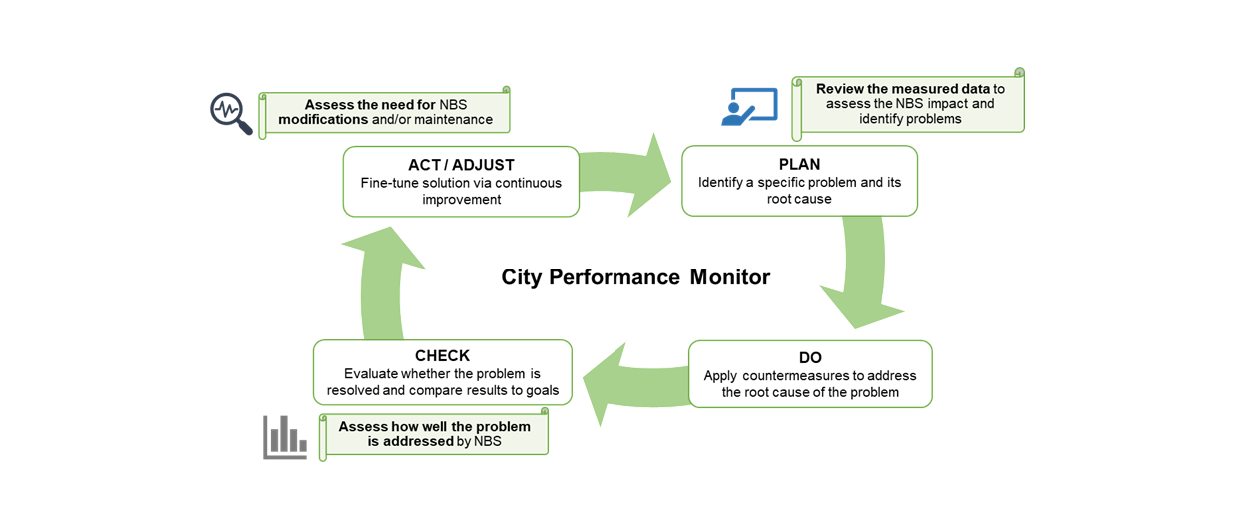
Co-monitor NBS performance and impact with the City Performance Monitor
- Tue, 18/05/2021
At the turn of the third decade of the 21st century, we find ourselves and our ideas living and thriving in a digital world. Today, making an impact and influencing decisions is made easier thanks to the various digital tools and software. In UNaLab, we strive to develop digital tools that help municipalities, cities and citizens influence the ways climate adaptation is approached in their cities. In this series of UNaLab ICT tools stories, we talk about the ICT tools developed and tested in UNaLab for supporting the implementation of nature-based solutions (NBS) in any city throughout and beyond the project duration at each stage, from co-creation to NBS monitoring. Each series will present a single UNaLab ICT tool and discuss its place in the adaptive management cycle* (or, Plan-Do-Check-Act cycle) of NBS implementation.
MONITORING THE ENVIRONMENTAL CONDITIONS AND NBS PERFORMANCES WITH THE CPM
In the previous newsletter, we presented the Open Nature Innovation Arena (ONIA), which helps citizens and municipalities identify common problems, and suggest and select improvement proposals. This time, we introduce the City Performance Monitor (CPM) – the UNaLab ICT tool that supports NBS performance and impact assessment, and enables the involvement of all the stakeholders – including citizens and non-expert users – in co-monitoring and data-driven decision-making.
CPM facilitates the understanding of key indicators of urban conditions providing intelligible representation of NBS performance, challenges and impacts via different views and interactive dashboards for data visualisation. In this way, the Municipality and the other stakeholders can use the CPM to review NBS monitoring data, validate identified issues and impacts through the provision of real-time measurements and comparison with associated indicators. Here, users can determine whether the implemented solutions – not only NBSs – have effectively addressed the identified problem(s). CPM can further support them in data-driven decision-making on the needed NBS modifications or maintenance and future investments.
To facilitate the backend KPI management activities, the CPM provides features to automate the periodical calculation, as well as to leverage in the actual measures coming from online data sources and sensor devices scattered in the city. These features are enabled by the interoperability mechanisms provided by the UNaLab ICT framework - the Digital Enabler, which is the digital transformation platform owned by ENGINEERING Ingegneria Informatica S.p.A.
Its place in the adaptive management can be summarised as in the figure below:

All these characteristics made the CPM a valid tool supporting the co-creation and co-monitoring activities in the Living Labs (LL) in the UNaLab front-runner cities: Genova (IT), Tampere (FI), and Eindhoven (NL).
HOW DOES CPM WORK IN PRACTICE?
All stakeholders can benefit from the use of the CPM as it differentiates the representation of the performance indicators based on the user type. The Municipality and expert users can visualise the complete set of measures and complex performance indicators, with which they can inspect the problems in detail, find the possible origins and monitor the impact of the implemented solutions. At the same time, citizens and other non-expert users can engage in the participatory planning and co-monitoring through easy-to-understand dashboards and simplified views providing aggregated performance indicators and real-time measurements.
During the Plan phase of the adaptive management cycle (image above), the Municipality can see all the complex indicators already managed by the CPM and collaborate with the other stakeholders on co-identifying the local challenges and the goals to be reached. According to that, the Municipality sets the CPM with the additional measures and the KPI to be monitored, as well as the target values to be followed. The Municipality can additionally set the automatic KPI calculation based on the collected data without any additional data collection burden. Moreover, the Municipality can with the support of expert users select a set of easy-to-understand indicators for creating an interactive dashboard specifically designed to facilitate the understanding for the citizens.
During the following Check phase, the Municipality and citizens can monitor the environmental conditions and assess the impact of the solution operative in the real environment. Using differentiated views, they can evaluate the trends and compare the current values with the targets.
During the following Act/Adjust phase, all the involved parties use the CPM to continue the monitoring and impact assessment. In this case, the Municipality with the support of the expert users can evaluate the possible corrective actions and the restart of the co-creation process based on the identified issues.
*Adaptive management cycle, or Plan-Do-Check-Act cycle, is an iterative process involving a series of actions aimed at continuous development and robust decision-making.